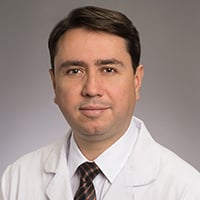ENRICH trial affirms minimally invasive stroke treatment
April 11, 2024
ENRICH trial sets new care standard
Groundbreaking results from a six-year clinical trial investigating treatment for hemorrhagic strokes, led by researchers at Emory University School of Medicine and Grady Health System, show the minimally invasive approach under study is safe and superior to the current standard of care, marking a major advancement in the treatment of intracerebral hemorrhage (ICH), the deadliest form of stroke.
The findings were published online April 10 by the New England Journal of Medicine (NEJM).
The study, named ENRICH (Early MiNimally-invasive Removal of ICH), was a randomized, multi-center, adaptive clinical trial conducted across 37 hospitals in the United States from 2017 to 2023. ENRICH enrolled 300 patients with spontaneous hemorrhagic stroke – 92 patients with a hemorrhage in the anterior basal ganglia location and 208 in the lobar location.
The study compared early (within 24 hours of a bleed) minimally invasive parafascicular surgery (MIPS), using the NICO Corporation’s BrainPath and Myriad technology, to the current standard of medical management (MM).
During the procedure, neurosurgeons use the BrainPath device to navigate through the intricate folds and fibers of the brain to reach the area of bleeding. It delicately displaces brain tissue to establish a passage to the bleeding spot. Upon reaching the target, the Myriad device, an automated tool for suction and resection, can then evacuate the clot.
“The results of the ENRICH trial not only demonstrate the efficacy and safety of MIPS, but they also herald a transformative milestone for the entire stroke community, changing the ICH treatment paradigm through a standardized approach and advanced technology,” says Gustavo Pradilla, MD, co-lead investigator for ENRICH, associate professor of neurosurgery at Emory University School of Medicine and chief of neurosurgery at Grady.
Key findings from ENRICH demonstrate MIPS offers significant improvements in outcomes for patients ICH. MIPS not only led to a statistically significant enhancement in utility-weighted modified Rankin Scale (UWmRS) scores at 180 days, but also reduced mortality rates at 30 days and shortened both ICU and hospital stays.
Specifically, MIPS showed a utility-weighted UWmRS of 0.458 at 180 days compared to 0.374 for MM, with a 98.1 percent posterior probability of superiority (95 percent CI, 0.005 to 0.163). Mortality rates were lower with MIPS at 9.3 percent versus 18.1 percent for MM. Additionally, MIPS reduced ICU length of stay by 2.8 days and hospital stay by 3.1 days.
Previous studies that compared surgical interventions with medical management indicated an increase in survival rates but did not demonstrate improvement in neurological function. However, for the first time, the ENRICH trial shows that in addition to reducing the risk of further brain damage and death, it also improves neurological function in patients with lobar ICH. This approach results in fewer adverse events and diminishes the necessity for emergency brain decompression surgeries.
“These findings mark a historic advancement in our field,” says Dan Barrow, the Pamela R. Rollins Chairman and Professor of Neurosurgery at Emory University and co-principal investigator. “We are immensely grateful to the 37 participating sites for their excellent execution of the trial and for our courageous patients and their families for placing their trust in us and participating in this important trial to further scientific understanding for the good of others.”
Every year, more than 2 million Americans and 3.4 million people globally experience hemorrhagic strokes, recognized as the most deadly, costly and debilitating type of stroke. Hemorrhagic stroke occurs when a weakened blood vessel ruptures and bleeds into the surrounding brain tissue, resulting in the accumulation of harmful blood within the brain. Regrettably, up 50 percent of Americans who suffer from hemorrhagic strokes will die within 30 days, and among survivors, only 25 percent will return to functional independence. In addition to the human toll, hemorrhagic stroke costs the U.S. healthcare system approximately $17 billion, with $12 billion in estimated annual costs of care and productivity losses for survivors.
“The ability to maximize the amount of clot evacuated in the safest manner is a pivotal advancement. We are steadfast in our commitment to collaborate with the medical community to educate on these interdisciplinary practices and foster their widespread adoption across institutions and specialties,” says Pradilla. “Together, we aspire to significantly improve the outcomes and lives of ICH patients, caregivers and loved ones.”
Other participating trial sites included: Mayo Clinic, Johns Hopkins University, Washington University, Cleveland Clinic Foundation, University of Southern California, Brigham and Women’s Hospital, Vanderbilt University, University of North Carolina and Penn State University.
At Emory, the ENRICH research team was comprised of a cross-disciplinary team from neurosciences and emergency medicine. In addition to Barrow and Pradilla, supporting Emory faculty members on this research include: co-principal investigator Jonathan Ratcliff, MD; Michael Frankel, MD; Jason W. Allen, MD, PhD; David Wright, MD; and Alex Hall, DHSc, MS, RN.
The ENRICH trial was sponsored by NICO Corporation, a medical technology company working to advance minimally invasive neurosurgical care.
To read the NEJM study, please visit: https://www.nejm.org/doi/full/10.1056/NEJMoa2308440.

